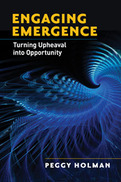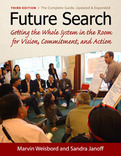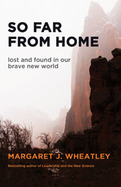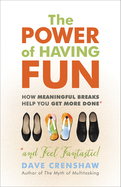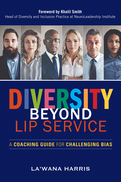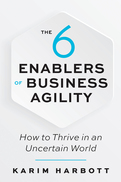2010
In this profound book, Peggy Holman offers principles, practices, and real-world stories to help you work with compassion, creativity, and wisdom through the entire arc of change—from disruption to coherence. You'll learn what to notice, what to explore, what to try, and what mindset opens new possibilities.
This work can be challenging but also tremendously rewarding. It enables new and unlikely partnerships and develops breakthrough projects. You become part of a process that transforms the culture itself.
-
Shows how to spot the emergence of a new level of order from the seemingly chaotic change that characterizes modern times
-
Offers practices and principles that will help you align yourself and your organization with the new order
-
Features real-world examples of individuals and organizations that have successfully navigated disruptive change
- 2011 Nautilus Gold Medal in the category of Conscious Business/Leadership
Change is everywhere these days, so much so that it can seem like barely-controlled chaos. As a result, increasing numbers of leaders, managers, workers and change agents feel overwhelmed. Some see too many choices, while others see no choices at all. But sometimes within this seeming chaos are the seeds of a higher order. Science calls the process of a new system arising from the ashes of the old emergence. Understanding the phenomenon of emergence can help leaders to gracefully and successfully cope with change and emerge stronger and more purposeful.
In this profound and insightful book, Peggy Holman offers new ways to think about the potential upheaval contains as a source of emergent change and shows how to engage it productively. This is is an art more than a science, so Holman offers practices that tell you not precisely what to do but rather how to approach disruptive situationswhat to notice, what to explore, what to try, what mindset will leave you most open to identifying the new paradigm as it emerges. She grounds these practices in five overarching principles that apply the scientific understanding of emergence in the natural world to social and organizational change processes. Real-world stories of collapse and renewal serve to illustrate these principles and practices in action. And Holman outlines three questions to help you work compassionately, creatively and wisely with the entire arc of the change process, from coherence to disruption to renewal.
This work can be difficultthe end is rarely in sight and the outcome is often uncertain. But it can also be tremendously exciting. Our survival in an increasingly unpredictable world is at stake, and working consciously with emergence is a promising pathway to doing something about it.
2010
-
The latest edition of the classic, definitive book on a change method proven effective worldwide
-
Thoroughly revised and updated, with nine new chapters
-
Provides a wealth of tools, handouts, and other practical aids
Future Search is one of the best established, most widespread and most effective methods for enabling groups of people to collectively move forward. It has been used all over the world for all kinds of purposes: to redesign an IKEA product line in Sweden, develop an integrated economic development plan in Northern Ireland, organize the demobilization child soldiers in Southern Sudan, and help a Hawaiian community reconnect with traditional values, This book, written by the originators of the process, is the most up-to-date edition of the definitive work on this powerful change method.
Incorporating input from the worldwide Future Search community, the third edition has been completely revised, reorganized and updated, including nine brand new chapters. There are new cases and examples throughout, as well as new material on using virtual technologies to hold Future Searches, combining Future Search with other change methods, and the growing global reach of Future Search. Marvin Weisbord and Sandra Janoff have greatly streamlined the process, providing specific guidance for Future Search sponsors, steering committees, participants, and facilitators, and new suggestions for how to sustain action after the Future Search is over. Theyve added information on the economic benefits of a Future Search, striking evidence of Future Searchs efficacy, information how Future Searches can go green, and more.
Future Search uniquely enables people to take down the walls that keep them apart, and Weisbord and Janoff take you through every step of the process. They include a wealth of resources such as handouts, sample client workbooks, follow-up reports, and other practical tools. If you want to do strategic planning, product innovation, quality improvement, organizational restructuring, or any other major change in a participative, whole system way, this book is your guide.
What sets this book apart from similar titles
- Other books in this field, such as Built to Change, contain a bias of top-down design which can make their suggestions unwieldy to implement. This book takes a more grassroots approach to searching for the future, where all stakeholders work cooperatively to create a shared vision of the future.
- It is an optimistic, aspiring book, which describes the change process as "an emotional rollercoaster" which can be upsetting at times but is overall exciting and fun. The Heart of Change Field Guide focuses more on the difficulties and obstacles of leading change within an organization (how to "get around" the people who drag you down, hold you back, etc.) Future Search's emphasis on both positivity and inclusivity sets it apart among change books.
- Future Search methods are so successful, that thousands of people around the world have sought and received training from the Future Search Network: http://www.futuresearch.net/.
2012
Combines penetrating insights into the problems and paradoxes of modern society with a fresh perspective on how to persevere in the face of unending challenges using the skills of insight and compassion.
AN INVITATION TO WARRIORSHIP I wrote this book for you if you offer your work as a contribution to others, whatever your work might be, and if now you find yourself feeling exhausted, overwhelmed, and sometimes despairing even as you paradoxically experience moments of joy, belonging, and greater resolve to do your work. This book describes how we can do our good work with dedication, energy, discipline, and joy by consciously choosing a new role for ourselves, that of warriors for the human spirit. This book contains maps of how we ended up in a world nobody wants—overtaken by greed, self-interest, and oppressive power—the very opposite of what we worked so hard to create. These maps look deeply into the darkness of this time so that we can develop the insight we need to contribute in meaningful ways. This book provides maps for the future, how we can transform our grief, outrage, and frustration into the skills of insight and compassion to serve this dark time with bravery, decency, and gentleness. As warriors for the human spirit, we discover our right work, work that we know is ours to do no matter what. We engage wholeheartedly, embody values we cherish, let go of outcomes, and carefully attend to relationships. We serve those issues and people we care about, focused not so much on making a difference as on being a difference.- Winner of the 2013 Nautilus Silver Award in Inner Prosperity/Right Livelihood
- By the bestselling author of Leadership and the New Science, Turning to One Another, and many other inspiring books
- Combines penetrating insights into the problems and paradoxes of modern society with a fresh perspective on how to persevere in the face of unending challenges using the skills of insight and compassion
- Wheatley's most personal work to date, dedicated to alleviating the exhaustion and despair of forward-thinking people
We live in a time of increasing polarization and irrationality, like a Tower of Babel with no distinction between fact and opinion, where information no longer changes minds. In cyberspace, we are bombarded with constant distractions and narcissistic self-making activities. Instant judgment and blame have replaced rational thinking. Organizations are bloated by bureaucracy and meaningless measures. Those working for positive change become exhausted, ill, and heartsick as their good work is ignored, underfunded, or attacked.
We need to acknowledge that we're lost in a world far different that we hoped for. We need new maps to navigate our brave new world. In Leadership and the New Science, Wheatley provided encouraging maps for how to design organizations based on living systems' capacity for inclusion, change, and adaptation. But in the twenty years since that book's publication, she's seen that in spite of our best efforts, the world that has emerged is on a destructive trajectory that won't be reversed by our working harder, finding new methods, or forming better networks.
But Wheatley has not written a book to increase our despair. Quite the contrary. Her intention is to inspire us to do our work with greater resolve and energy, using maps that won't mislead us. So Far From Home offers maps of two kinds. Using the newest of the new sciences, Wheatley shows how different dynamics interacted to create this harsh new world. A second kind of map invites us to choose a new role for ourselves as warriors for the human spirit. We develop the skills we need mostinsight, bravery, decency, compassionas we look honestly at this complex, difficult world. Clarity gives us enduring strength to discover our right work and create meaningful lives in this dark time.
So Far From Home is a startlingly honest, profoundly reflective, and yet paradoxically down-to-earth book rooted in the day-to-day experiences we all share but seen with fresh eyes. It is both affirming and provoking, calling us to reexamine our expectations and redefine our role for the work ahead. It is Wehatley's most personal, heartfelt work to date.
If you want to be successful, having fun is not an option. It's a necessity. By making fun a top priority—taking meaningful, enjoyable breaks each day, week, month, and year—you'll not only be happier but be more productive, too!
Using scientific evidence, real-world case studies, and a healthy dose of wit, bestselling author Dave Crenshaw shows that a regular respite is like a little oasis in your workday. It refreshes and reinvigorates, recharges your batteries—helping you accomplish more with less effort!
The Power of Having Fun coaches you through the five-step system thousands of leaders have utilized to boost productivity and propel their careers—all while feeling fantastic! Let Dave Crenshaw lower your stress, raise your results, and restore recess to your routine.
—Marshall Goldsmith, Thinkers 50 #1 Executive Coach and two-time #1 Leadership Thinker in the world
The ugly truth about diversity is that some people worry they must give up their power for others to have a chance. La'Wana Harris's Inclusion Coaching method helps people realize that sharing power isn't the same as losing it.
The elephant in the room with diversity work is that people with privilege must use it to allow others equal access to power. This is often why diversity efforts falter—people believe in diversity until they feel that they have to give something up. How do we talk them through this shift?
La'Wana Harris introduces Inclusion Coaching, a new tool based on cutting-edge research that identifies the stages of preparation, implementation, and “self-work” necessary to help individuals, teams, and organizations build a sustainable culture of inclusion. Harris's six-stage COMMIT model—Commit to courageous action, Open your eyes and ears, Move beyond lip service, Make room for controversy and conflict, Invite new perspectives, and Tell the truth even when it hurts—provides a proven process for making people aware of their own conscious and unconscious biases and concrete steps to make inclusion an embedded reality.
Harris offers managers and diversity coaches new models to empower everyone from employees to CEOs to “do” inclusion and address deep-rooted biases that are often invisible. She addresses the growing need to challenge bias and build authentic cultures where everyone can feel a sense of belonging.
Many managers struggle to install the underlying organizational operating system for business agility. High-performing agile organizations depend on the strength of six key enabling factors: leadership, culture, structure, people, governance, and ways of working. This book explains why these factors are important and how they work together to increase organizational agility. Real-world examples, stories, and tools will help leaders get realistic about the scope of changes needed in their organizations and show them how to get started.
Karim Harbott does not offer a book of recipes. Instead, he focuses on mindset, principles, and general patterns. This book summarizes of the most important factors in increasing organizational agility and why they work, which leaders will need to consider in a so-called agile transformation. Because every organization is different, each will have its own route to agility and high performance. Managers will need to tackle all the areas that are crucial to creating an environment in which any chosen approach can work.


